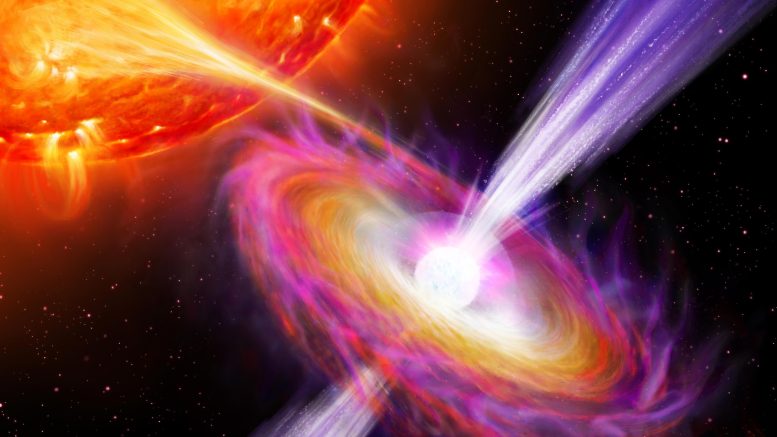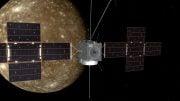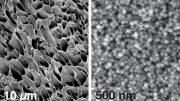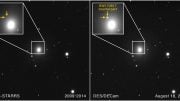
This artist’s impression depicts how nuclear explosions on a neutron star feed the jets blasting off from its magnetic polar regions. In the foreground, at the center right, there is a very bright white ball, representing the neutron star. White/purple filaments are streaming out from its polar region. The ball is surrounded by a hazy white larger sphere, the corona, and further out by a disk with concentric bands of different colors, going from white in the inner disk to orange in the middle and to red-magenta in the outer region. An orange band connects the outer part of the disk to a large yellow-orange-red section of a sphere in the top left corner. This represents the star companion of the neutron star, that is feeding the disk around the bright white spherical body. Credit: Danielle Futselaar and Nathalie Degenaar, Anton Pannekoek Institute, University of Amsterdam
Astronomers have successfully measured the velocity of rapidly moving jets in space for the first time, a critical factor in the formation of stars and the dispersal of essential life-building elements.
Astronomers have, for the first time, measured the speed of high-velocity jets in space, playing a pivotal role in star formation and the distribution of life-essential elements.
The jets of matter, expelled by stars deemed ‘cosmic cannibals’, were measured to travel at over one-third of the speed of light – thanks to a groundbreaking new experiment published in Nature.
The study sheds new light on these violent processes, making clever use of runaway nuclear explosions on the surface of stars.
Co-Author Jakob van den Eijnden, Warwick Prize Fellow at the Department of Physics, University of Warwick, said: “The explosions occurred on neutron stars, which are incredibly dense and notorious for their enormous gravitational pull that makes them swallow gas from their surroundings – a gravitational pull that is only surpassed by black holes.
Detailed Mechanism of Jet Formation
“The material, mostly hydrogen from a nearby star that orbits around, swirls towards the collapsed star, falling like snow across its surface. As more and more material rains down, the gravitational field compresses it until a runaway nuclear explosion is initiated. This explosion impacts the jets, that are also shot out from the infalling material and eject particles into space at very high speed.”
The team devised a way of measuring the speed and properties of the jets by comparing X-ray and radio signals picked up by the Australia Telescope Compact Array (owned and operated by CSIRO, Australia’s national science agency) and the European Space Agency’s (ESA’s) Integral satellite.
Co-Author Thomas Russell, National Institute for Astrophysics, INAF, Palermo, Italy, said: “This gave us a perfect experiment. We had a very brief short-lived impulse of extra material that gets shot into the jet and that we can track as it moves down the jet to learn about its speed.”
This artistic animation illustrates how nuclear explosions on a neutron star feed the jets blasting off from its magnetic polar regions. When in orbit with another star, the neutron star’s intense gravitational field can ‘suck’ material away from the nearby companion. The material swirls towards the collapsed object, circling it, forming a disk, and ultimately plunging to the surface. The crashing gravity on the neutron star’s surface violently compresses the accumulated material (consisting mostly of hydrogen) causing a runaway nuclear explosion. This in turn triggers the jets to suddenly intensify and eject particles into space at very high speed. Credit: ESA – European Space Agency Acknowledgments: D. Futselaar and N. Degenaar, University of Amsterdam. Work performed by ATG Medialab under contract with ESA
Observational Challenges and Results
Jakob van den Eijnden added: “These explosions occur every couple of hours, but you can’t predict exactly when they will happen. So you have to stare at the telescope observations for a long time, and hope you catch a couple of bursts. Over three days of observations, we saw 10 explosions and jets lighting up.”
The jets traveled around 114,000 kilometers per second, an incredible 35-40% of the speed of light.
This was the first time astronomers had been able to anticipate and directly watch how a certain amount of gas got channeled into a jet and accelerated into space.
Co-Author Nathalie Degenaar, University of Amsterdam, the Netherlands, continued: “Based on previous data, we thought the explosion would destroy the location where the jet was being launched. But we saw exactly the opposite: a strong input into the jet rather than a disruption.”
The researchers believe the mass and rotation of neutron stars and black holes also impacts the jets.
Having now shown this research is possible, this study will form the blueprint for future experiments into neutron stars and their jets. Jets can also be produced by cataclysmic events such as supernova explosions and gamma-ray bursts. The new results will have wide applicability in many studies of the cosmos.
Reference: “Thermonuclear explosions on neutron stars reveal the speed of their jets” by Thomas D. Russell, Nathalie Degenaar, Jakob van den Eijnden, Thomas Maccarone, Alexandra J. Tetarenko, Celia Sánchez-Fernández, James C. A. Miller-Jones, Erik Kuulkers and Melania Del Santo, 27 March 2024, Nature.
DOI: 10.1038/s41586-024-07133-5









Be the first to comment on "“Cosmic Cannibals” – Astonishing Speeds of Stellar Jets Unveiled for the First Time"